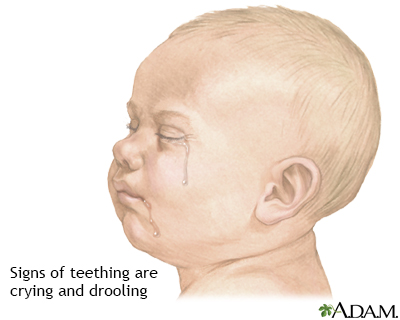Teething
Eruption of primary teeth; Well child care - teething
Teething is the growth of teeth through the gums in the mouth of infants and young children.

The structure of the tooth includes dentin, pulp and other tissues, blood vessels and nerves imbedded in the bony jaw. Above the gum line, the tooth is protected by the hard enamel covering.

Both baby teeth (deciduous or milk teeth) and permanent teeth have fairly well-defined times of eruption. The ages listed are the normal ages that a baby tooth emerges. Upper central incisors and upper lateral incisors erupt by 8 to 10 months. Upper canines (cuspids) erupt by 16 to 20 months. Upper first molars erupt by 15 to 21 months. Upper second molars erupt by 20 to 24 months. Lower central incisors erupt by 6 to 9 months. Lower lateral incisors erupt by 15 to 21 months. Lower canines (cuspids) erupt by 15 to 21 months. Lower first molars erupt by 15 to 21 months. Lower second molars erupt by 20 to 24 months.

Children typically begin to erupt a tooth between the 6th and 8th month of life. Signs of teething are drooling, irritability, gum swelling and sensitivity, sleeping problems, refusing food, the urge to bite on hard objects and possibly a low grade fever. The discomfort that results from teething is due to the pressure exerted on the tissue in the mouth, called the periodontal membrane, as the teeth erupt.
Information
Teething generally begins when a child is between 6 and 8 months old. All 20 baby teeth should be in place by the time a child is 30 months old. Some children do not show any teeth until much later than 8 months, but this is usually normal for the child and not due to a disease.
- The two bottom front teeth (lower incisors) often come in first.
- Next to grow in are usually the two top front teeth (upper incisors).
- Then the other incisors, lower and upper molars, canines, and finally the upper and lower lateral molars come in.
The signs of teething are:
- Acting cranky or irritable
- Biting or chewing on hard objects
- Drooling, which may often begin before teething starts
- Gum swelling and tenderness
- Refusing food
- Sleeping problems
Teething does not cause fever or diarrhea. If your child develops a fever or diarrhea and you are worried about it, contact your child's health care provider.
Tips to ease your child's teething discomfort:
- Wipe your child's face with a cloth to remove the drool and prevent a rash.
- Give your child a cool object to chew on, such as a firm rubber teething ring or a cold apple. Avoid liquid-filled teething rings, or any plastic objects that might break.
- Gently rub the gums with a cool, wet washcloth, or (until the teeth are right near the surface) a clean finger. You may place the wet washcloth in the freezer first, but wash it before using it again.
- Feed your child cool, soft foods such as applesauce or yogurt (if your child is eating solids).
- Use a bottle, if it seems to help, but only fill it with water. Formula, milk, or juice can all cause tooth decay.
You can buy the following medicines and remedies at the drug store:
- Acetaminophen (Tylenol and others) or ibuprofen can help when your child is very cranky or uncomfortable.
- If your child is 2 years or older, teething gels and preparations rubbed on the gums may help the pain for a short while. Be careful not to use too much. Do not use these remedies if your child is younger than 2 years old.
Be sure to read and follow package instructions before using any medicine or remedy. If you are not sure how to use it, contact your child's provider.
What not to do:
- Do not tie a teething ring or any other object around your child's neck.
- Do not place anything frozen against your child's gums.
- Never cut the gums to help a tooth grow in, because this can lead to infection.
- Avoid teething powders.
- Never give your child aspirin or place it against the gums or teeth.
- Do not rub alcohol on your child's gums.
- Do not use homeopathic remedies. They may contain ingredients that are not safe for infants.
References
American Academy of Pediatrics website. When does teething start?
American Academy of Pediatric Dentistry. Policy on oral health care programs for Infants, children, adolescents, and individuals with special health care needs. The Reference Manual of Pediatric Dentistry. Chicago, Ill.: American Academy of Pediatric Dentistry; 2024: 83-5.
Turner EG, Dean JA. Eruption of the teeth: local, systemic, and congenital factors that influence the process. In: Dean JA, ed. McDonald and Avery's Dentistry for the Child and Adolescent. 11th ed. St Louis, MO: Elsevier; 2022:chap 20.
Version Info
Last reviewed on: 10/20/2024
Reviewed by: Neil K. Kaneshiro, MD, MHA, Clinical Professor of Pediatrics, University of Washington School of Medicine, Seattle, WA. Also reviewed by David C. Dugdale, MD, Medical Director, Brenda Conaway, Editorial Director, and the A.D.A.M. Editorial team.
